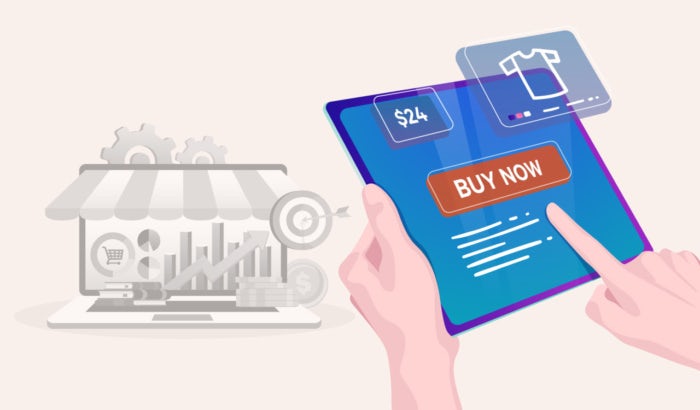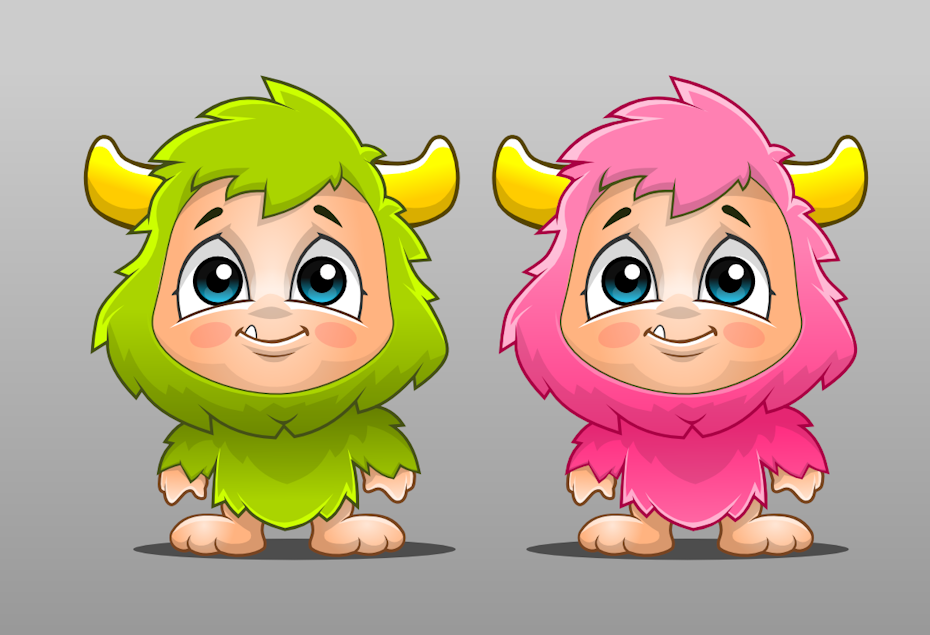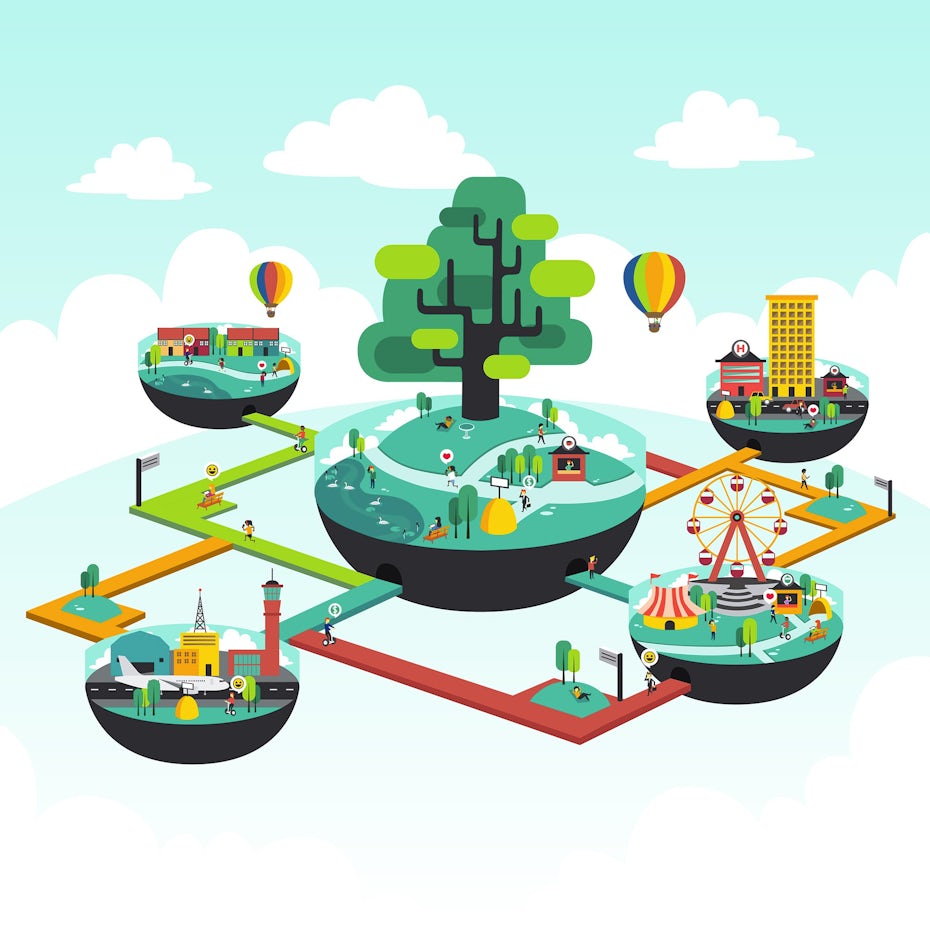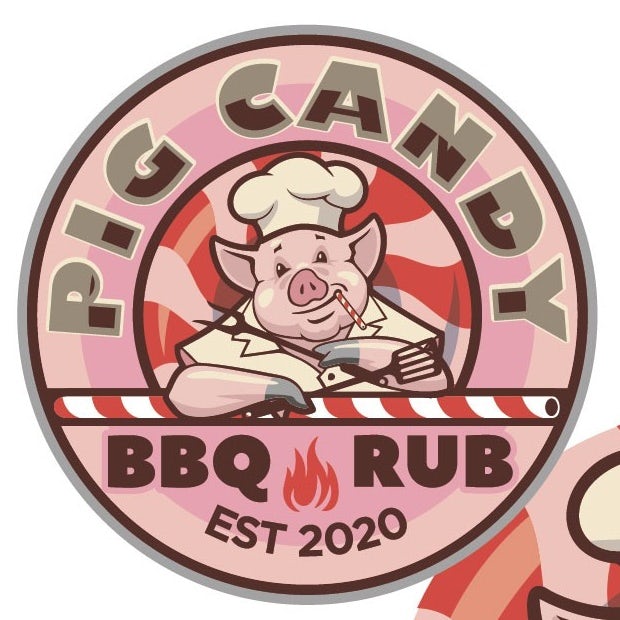What’s the difference between ecommerce and brick-and-mortar retail? With brick-and-mortar stores, it’s possible to make sales without doing any marketing yourself. It’s hard, and you’ll make way less than if you did have a marketing strategy, but people driving by your shop might stop in if it piques their interest. With ecommerce marketing, there’s no random popping in—you’ve got to drive customers there yourself!

No one’s going to pass by your online store by accident. There’s no sidewalk where you can plop a fold-up chalkboard with a cheeky slogan that entices people through the door. You need to proactively tell people your shop exists and show them what you’re offering, and the best way to do that is ecommerce marketing using sales funnels, an interconnected series of marketing campaigns that each nudge shoppers a step closer to a purchase.
Trust us, becoming a pro at ecommerce marketing and setting up effective sales funnels isn’t as difficult as it sounds. You’ve encountered them loads of times before and, once you understand the components that make up the funnel (and by extension the larger ecommerce marketing strategy), you’ll be able to emulate them perfectly for your own brand.
The ecommerce marketing funnel explained
—
You’re probably familiar with the term “sales funnel,” but can you thoroughly explain how it works? If you can’t, that’s okay; we’re going to break it down for you right now. The easiest way to understand the sales funnel is to use the AIDA model: Awareness, Interest, Decision and Action.

Imagine all the people out there on the internet, whether they’re people who connect with your brand or not. Billions of people around the world use the internet every day, but not all of them—in fact, not even most of them—are the same people your brand is targeting.
A funnel is how you sift through those billions and billions of people to connect with the subset who will actually buy from your online store. You start by making your audience aware of your brand—if they don’t know about your store or the products you’re offering, they won’t buy from you.
As the first step in your ecommerce marketing strategy, the awareness stage, is where you cast the widest “net.” (That’s why it’s called a “funnel;” you start with more general and far-reaching aims, and then gradually get narrower and more focused as your move on.)

Your goal at the beginning is to make your audience aware of your brand in a bunch of different ways: using hashtags they use, running ads where they’ll see them, maintaining an active social media presence and publishing content relevant to them, like blog posts and videos about topics they enjoy.
Another favorite strategy is using what’s called a lead magnet to spark awareness and turn that awareness into interest. A lead magnet is a giveaway you offer up in exchange for your audience’s contact information, usually their email addresses. If you’ve ever taken a personality quiz online that required your email address to get the results, you’ve interacted with a lead magnet. Other popular kinds of lead magnets include:
- Exclusive content
- Short trainings
- Ebooks
- Checklists and cheat sheets
- Templates
- Toolkits
When you offer a lead magnet, not everybody who sees it will want it and opt in. Those who do want it and opt in are now considered “in the funnel,” where they begin moving along toward making a purchase.
After the awareness stage, you’ve got the interest stage, where interested prospects have their interest piqued further. It’s where you leverage those emails you collected earlier and deliver on the lead magnet, and also where you strengthen your relationship with potential customers through even more relevant content or directly into why your products are so great. If you’ve collected emails for a newsletter, you can use those regular correspondence to highlight certain products and share company news like sales events and discounts.

Outside of email, your social media and content marketing campaigns come in handy during this stage. The more people are reading about you and your products, whether on blogs or social media feeds, the more interested they become.
The next step down the funnel is called the decision stage, where your prospects literally decide whether to buy from you or not. Usually, they need some convincing, and some of the most effective approaches include:
- Social proof. This means seeing other people enjoying your brand to verify it’s worthwhile, like testimonials from past clients (preferably well-known ones), or positive reviews and social media posts about you from friends and family.
- Thoughtful posts proving your unique value proposition—it’s not enough to just say your product is the best in its category, you’ve got to show your prospects it’s the best choice for them
- Free trials or samples, depending on your offer.
Although prospects decide whether they’ll buy in the decision stage, that’s not the end of the funnel. It’s one thing to decide you want to buy, but it’s another to actually click that “buy now” button.
This brings us to the final stage in your sales funnel, the action stage—the crux of your entire ecommerce marketing strategy. You’ve opened the door for your prospects, but now they need to walk through it. The ones who truly want what you’re offering will buy it, but it doesn’t hurt to sweeten the deal a little for those who are still apprehensive. Here’s a few ways you can do that:
- Offering free shipping
- Offering a discount on the buyer’s first order
- Offering a raffle entry with purchase or another opportunity to win something

The right offer depends on your product or service. For SaaS products, your action stage clincher might be free or discounted migration for new customers. For plush toys, it might be a BOGO offer (buy one, get one free).
As you’ve probably realized, the journey from awareness to action isn’t always neat and linear. Somebody might find your brand through their Explore page on Instagram, check out your profile, then make a purchase without getting on your email list or reading testimonials. The important thing is that you have all these options in place for the people who need them—otherwise, you’re just limiting yourself and your sales.
Type of ecommerce marketing: putting the funnel into action
—
Your brand is unique, so the ecommerce marketing strategy you use should be unique as well. Your funnel might be relatively simple, using just one or two strategies, or it might be complex, with lots of strategies at once and multiple streams of prospects channeling together into one large mega-funnel.

Here’s a few popular ecommerce marketing strategies you can use to build your funnel:
Social media
If you use social media, you’ve seen social media ads. In fact, you’ve seen lots and lots of social media ads… and you’ve probably even bought things through them. Social media ads, and your entire social media presence for that matter, tell the world about your brand and give your followers a direct path to your online store.
Not all social media ads are the same—you can run ads that directly advertise your products and services and you can run ads that amplify your brand’s social media presence. Ads in the first category typically showcase specific products or services and have calls to action like “buy now,” “call now” and “book an appointment.” The second kind of ad, ads that spread awareness, usually showcase your brand as a whole or offer up a lead magnet. These ads usually have calls to action for liking, following or subscribing to your page.
The other way to market your brand on social media is to simply be on social media. Answering customer questions, addressing their complaints, sharing news and simply engaging in conversations with your followers all humanize your brand, building awareness and sparking interest from the people who follow you. Luckily, this ecommerce marketing strategy costs you nothing but time.
Email marketing
Email marketing is one of the oldest and most widely used types of ecommerce marketing because, simply put, it works. According to OptinMonster, email clickthrough rates are six times higher than Facebook, Instagram and Twitter engagement rates combined.
Email marketing is more than just sending email newsletters to the addresses on your list. It also includes strategic emails to achieve certain goals, like abandoned cart reminders. Basically, email covers all your bases. You can tell your followers about discounts and promotions, you can let them know you’ve posted new content on the blog, you can offer them lead magnets and you can have close conversations that make your brand feel more like a close friend.
Email marketing fits into different stages of your sales funnel, specifically interest, decision and action. Different emails achieve different goals and as you build email campaigns you’ll see your funnel taking shape with them.
Blogging & vlogging
Written blogs and video blogs are two types of content marketing great at getting your brand on your prospects’ radar. Create the kind of content your prospects want, and if you’re not sure what they want, take a look at what kinds of content other brands like yours are publishing.

If you’re a clothing brand, blog posts about styling the garments you carry could be helpful. If you’re a brand for pet products, your followers might enjoy a video roundup of the most unique cat breeds or a compilation of dogs doing hilarious things.
Think outside the box when you’re planning your content calendar and give your prospects something that grabs their attention. Blogs and videos, like emails, fit into a few different funnel segments.
Beyond grabbing prospects’ attention, they share information that makes your brand appealing to prospective buyers (the interest stage). They can also showcase social proof and, if you’re publishing guest blogs, be the social proof.
SEO
Search engine optimization (SEO) is the art and science of making your pages rank higher on search engines. Most people think of keywords when they think of SEO, but there’s actually more to it than that. SEO also involves publishing high quality, relevant content, having a website that loads quickly, links to other websites and, yes, effective design.
SEO sits at the top of your funnel. By optimizing your ads and website for search engines, you’re helping to connect with more people who are searching for the products or services you offer—even if they’re not yet aware you exist.
SEA
Search engine advertising (SEA) refers to getting your products to appear high in search engine results by paying for ad spaces. One of the ways to do this is pay-per-click campaigns, also known as PPC campaigns, which are tantalizing ads placed on search engine results pages that you only pay for when users click them. Another is Google Shopping campaigns, which is where you pay to place listings for your products at the top of any Google Shopping search results for your keywords.
Just like SEO, SEA sits at the top of your funnel, getting eyes on your ads and ideally clicks on your links from people who want to get to know your brand better.
User-generated marketing
User-generated marketing is basically encouraging your followers do your marketing for you. This can be part of a social media marketing strategy, like creating a hashtag for them to use or sharing their posts, or it could be as simple as featuring customer reviews on your channels.
With its built-in social proof, user-generated marketing fits into multiple segments of your funnel. At the top, it’s a great awareness-builder because when people see your brand in their friends’ posts, they learn your name and start to recognize it when it pops up again in their feeds and search results. It’s also an interest-builder, because seeing your brand out “in the wild” makes prospects go, “hmm, that’s a cool product. I should check it out.” And once they’ve checked out your site, knowing you’ve already got tons of fans is often the last push they need to decide, “yep, I’m buying this.”
Local marketing
Lastly, remember that ecommerce marketing doesn’t just have to happen online. Print ads, banners, events—there are lots of IRL ways to promote your ecommerce business. You might get a ton of traction by grabbing a vendor spot at a local fair or pop-up shopping space, especially if you’re offering a tangible product. Just like user-generated marketing builds awareness and conjures up interest, so too does local marketing.
Local marketing also does something user-generated content can’t do: let prospects try before they buy. No matter how ubiquitous ecommerce becomes, there are still people who are wary about buying products online—especially things like clothing, beauty and skincare products that buyers want to try out in person before they commit to buying. By participating in local events, you give potential buyers the opportunity to touch your product, try it on and decide from there whether it’s for them.
Finding the type of ecommerce marketing that works best for you

You don’t have to do every type of ecommerce marketing to be successful. In fact, you’ll probably be more successful if you do one or two strategies really well than if you try to do them all and end up spreading your marketing budget thin.
For your first campaigns, grab “low-hanging fruit”—i.e., ecommerce marketing strategies that won’t suck up all your time and money, like posting to social media every day and researching which hashtags connect best with your audience. Another way to determine which strategies are best for your brand is to look at how brands like yours are marketing themselves and draw inspiration from them. That doesn’t mean copying them directly, but studying their strategies to understand why these strategies work and how you can use the same strategies to reach your target audience.
Ecommerce marketing also isn’t the place to stay stuck in the past. As you map out which approaches to try, pay close attention to the latest trends and why they’re working so well. Today, brands are using strategies like live chat and artificial intelligence to give site visitors personalized experiences with their stores, not unlike speaking with a live employee.
Analyzing your strategies’ results
—
As you make use of different ecommerce marketing strategies, analyze your results. By doing this, you’ll be able to fine-tune future marketing campaigns to target and convert your prospects more effectively.
With strategies like email marketing and social media ads, analytics tools are built into the software you use. You’re able to collect data on everything relevant to your campaigns, like where in the world your website’s traffic is coming from, how many people saw your ad versus how many clicked on it, how many people opened your email and, of them, how many actually followed the links inside. Other relevant information is whether your traffic’s coming primarily from desktop or mobile, which browsers your prospects are using most and information about their demographics.

The data you collect helps you reformat your funnel to make it more efficient. For starters, you can more accurately target your ads and tweak your branding to appeal to your top demographics in particular. Even more important, you can locate any blockages in the funnel. You might determine that a lot of people are seeing your ads, but very few are actually clicking them. If that’s the case, you’ve got to focus on the top of your funnel and really amp up your efforts in building awareness and interest.
If, instead, you’ve got plenty of followers and subscribers, but far too few buyers by comparison, you’ve got a block in the bottom of your funnel. In that case, your focus needs to be getting your followers confident enough in your product to click “buy,” which could mean adding an abandoned cart email to your store’s system or offering a limited time discount.
Creating your ecommerce marketing strategy
—
Ready to start developing your unique ecommerce marketing strategy?
Before you can start doing any sort of effective ecommerce marketing, you need a clearly defined brand. If you don’t have one yet, read our guide to ecommerce branding and craft a three-dimensional persona for your brand. Once you’ve fleshed out what kind of brand you want, use that as design cues for your:

- Logo
- Website
- Email templates
- Copy voice
- Graphics and other imagery
- Social media profiles
- Advertising
- Product packaging
- Product design
After your brand’s ready to hit the web, it’s time to create a responsive, on-brand website and matching social media pages. After that, it’s time to test out ecommerce marketing strategies like paid ads and lead magnets. Start small and work your way up—connecting with influencers and collaborating with other brands are strategies that work better when you’ve got some industry clout, so put them on the back burner for now.
As you try different strategies, zero in on what works for your brand and focus your resources on that. You might even want to hire a marketing consultant to guide you or even a full-scale marketing agency to handle marketing on your behalf, but remember this can get pricey. Whether you do it yourself or hire a consultant/agency depends on your budget and how comfortable you feel doing your own ecommerce marketing.
Get the most out of your ecommerce marketing efforts with great design
—
No matter which platforms and campaign types your ecommerce marketing strategy involves, it’s got to include great design. Even a perfectly executed email campaign or social media presence falls apart if it doesn’t look good. And looking good is only part of great design—your design’s also got to work, which means it’s got to show followers not only what you’re offering, but also why it’s so amazing.
Don’t doom your ecommerce store with less-than-stellar design. Connect with an experienced designer to create an unstoppable sales-generating ecommerce marketing machine.
Need a logo, website or infographic designed?
Our designers can create just about anything you need.
The post The ultimate guide to ecommerce marketing appeared first on 99designs.
No comments:
Post a Comment